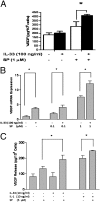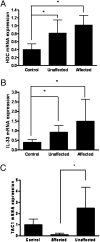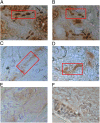IL-33 augments substance P-induced VEGF secretion from human mast cells and is increased in psoriatic skin
- PMID: 20160089
- PMCID: PMC2840132
- DOI: 10.1073/pnas.1000803107
IL-33 augments substance P-induced VEGF secretion from human mast cells and is increased in psoriatic skin
Abstract
The peptide substance P (SP) has been implicated in inflammatory conditions, such as psoriasis, where mast cells and VEGF are increased. A relationship between SP and VEGF has not been well studied, nor has any interaction with the proinflammatory cytokines, especially IL-33. Here we report that SP (0.1-10 microM) induces gene expression and secretion of VEGF from human LAD2 mast cells and human umbilical core blood-derived cultured mast cells (hCBMCs). This effect is significantly increased by coadministration of IL-33 (5-100 ng/mL) in both cell types. The effect of SP on VEGF release is inhibited by treatment with the NK-1 receptor antagonist 733,060. SP rapidly increases cytosolic calcium, and so does IL-33 to a smaller extent; the addition of IL-33 augments the calcium increase. SP-induced VEGF production involves calcium-dependent PKC isoforms, as well as the ERK and JNK MAPKs. Gene expression of IL-33 and histidine decarboxylase (HDC), an indicator of mast cell presence/activation, is significantly increased in affected and unaffected (at least 15 cm away from the lesion) psoriatic skin, as compared with normal control skin. Immunohistochemistry indicates that IL-33 is associated with endothelial cells in both the unaffected and affected sites, but is stronger and also associated with immune cells in the affected site. These results imply that functional interactions among SP, IL-33, and mast cells leading to VEGF release contribute to inflammatory conditions, such as the psoriasis, a nonallergic hyperproliferative skin inflammatory disorder with a neurogenic component.
Conflict of interest statement
The authors declare no conflict of interest.
Figures






Similar articles
-
SP and IL-33 together markedly enhance TNF synthesis and secretion from human mast cells mediated by the interaction of their receptors.Proc Natl Acad Sci U S A. 2017 May 16;114(20):E4002-E4009. doi: 10.1073/pnas.1524845114. Epub 2017 May 1. Proc Natl Acad Sci U S A. 2017. PMID: 28461492 Free PMC article.
-
Mercury induces inflammatory mediator release from human mast cells.J Neuroinflammation. 2010 Mar 11;7:20. doi: 10.1186/1742-2094-7-20. J Neuroinflammation. 2010. PMID: 20222982 Free PMC article.
-
Substance P and IL-33 administered together stimulate a marked secretion of IL-1β from human mast cells, inhibited by methoxyluteolin.Proc Natl Acad Sci U S A. 2018 Oct 2;115(40):E9381-E9390. doi: 10.1073/pnas.1810133115. Epub 2018 Sep 19. Proc Natl Acad Sci U S A. 2018. PMID: 30232261 Free PMC article.
-
VEGF, substance P and stress, new aspects: a revisited study.J Biol Regul Homeost Agents. 2010 Jul-Sep;24(3):229-37. J Biol Regul Homeost Agents. 2010. PMID: 20846471 Review.
-
Mast Cell Cytokines IL-1, IL-33, and IL-36 Mediate Skin Inflammation in Psoriasis: A Novel Therapeutic Approach with the Anti-Inflammatory Cytokines IL-37, IL-38, and IL-1Ra.Int J Mol Sci. 2021 Jul 28;22(15):8076. doi: 10.3390/ijms22158076. Int J Mol Sci. 2021. PMID: 34360845 Free PMC article. Review.
Cited by
-
Interleukin-33: a mediator of inflammation targeting hematopoietic stem and progenitor cells and their progenies.Front Immunol. 2013 May 6;4:104. doi: 10.3389/fimmu.2013.00104. eCollection 2013. Front Immunol. 2013. PMID: 23653627 Free PMC article.
-
Biologic therapies in the treatment of psoriasis: a comprehensive evidence-based basic science and clinical review and a practical guide to tuberculosis monitoring.Clin Rev Allergy Immunol. 2013 Apr;44(2):121-40. doi: 10.1007/s12016-012-8301-7. Clin Rev Allergy Immunol. 2013. PMID: 22311162 Review.
-
Activation of Mast Cells by Neuropeptides: The Role of Pro-Inflammatory and Anti-Inflammatory Cytokines.Int J Mol Sci. 2023 Mar 2;24(5):4811. doi: 10.3390/ijms24054811. Int J Mol Sci. 2023. PMID: 36902240 Free PMC article. Review.
-
Autoantibodies to IgE can induce the release of proinflammatory and vasoactive mediators from human cardiac mast cells.Clin Exp Med. 2023 Aug;23(4):1265-1276. doi: 10.1007/s10238-022-00861-w. Epub 2022 Jul 25. Clin Exp Med. 2023. PMID: 35879625 Free PMC article.
-
Substance P accelerates the progression of human esophageal squamous cell carcinoma via MMP-2, MMP-9, VEGF-A, and VEGFR1 overexpression.Mol Biol Rep. 2020 Jun;47(6):4263-4272. doi: 10.1007/s11033-020-05532-1. Epub 2020 May 20. Mol Biol Rep. 2020. Retraction in: Mol Biol Rep. 2024 Nov 29;52(1):26. doi: 10.1007/s11033-024-10141-3. PMID: 32436041 Retracted.
References
-
- Leeman SE, Ferguson SL. Substance P: An historical perspective. Neuropeptides. 2000;34:249–254. - PubMed
-
- O’Connor TM, et al. The role of substance P in inflammatory disease. J Cell Physiol. 2004;201:167–180. - PubMed
-
- Kawana S, Liang Z, Nagano M, Suzuki H. Role of substance P in stress-derived degranulation of dermal mast cells in mice. J Dermatol Sci. 2006;42:47–54. - PubMed
-
- Kandere-Grzybowska K, et al. Stress-induced dura vascular permeability does not develop in mast cell-deficient and neurokinin-1 receptor knockout mice. Brain Res. 2003;980:213–220. - PubMed
-
- Saraceno R, Kleyn CE, Terenghi G, Griffiths CE. The role of neuropeptides in psoriasis. Br J Dermatol. 2006;155:876–882. - PubMed
Publication types
MeSH terms
Substances
Grants and funding
LinkOut - more resources
Full Text Sources
Other Literature Sources
Medical
Research Materials
Miscellaneous

